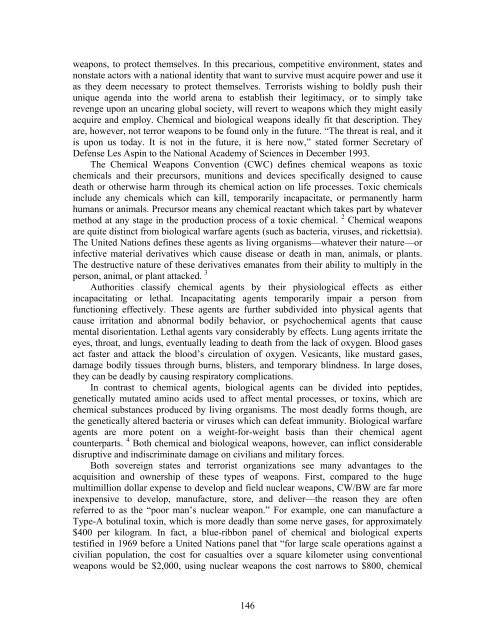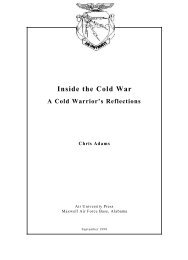Global Security Concerns - Project Gutenberg Consortia Center
Global Security Concerns - Project Gutenberg Consortia Center
Global Security Concerns - Project Gutenberg Consortia Center
You also want an ePaper? Increase the reach of your titles
YUMPU automatically turns print PDFs into web optimized ePapers that Google loves.
weapons, to protect themselves. In this precarious, competitive environment, states and<br />
nonstate actors with a national identity that want to survive must acquire power and use it<br />
as they deem necessary to protect themselves. Terrorists wishing to boldly push their<br />
unique agenda into the world arena to establish their legitimacy, or to simply take<br />
revenge upon an uncaring global society, will revert to weapons which they might easily<br />
acquire and employ. Chemical and biological weapons ideally fit that description. They<br />
are, however, not terror weapons to be found only in the future. “The threat is real, and it<br />
is upon us today. It is not in the future, it is here now,” stated former Secretary of<br />
Defense Les Aspin to the National Academy of Sciences in December 1993.<br />
The Chemical Weapons Convention (CWC) defines chemical weapons as toxic<br />
chemicals and their precursors, munitions and devices specifically designed to cause<br />
death or otherwise harm through its chemical action on life processes. Toxic chemicals<br />
include any chemicals which can kill, temporarily incapacitate, or permanently harm<br />
humans or animals. Precursor means any chemical reactant which takes part by whatever<br />
method at any stage in the production process of a toxic chemical. 2 Chemical weapons<br />
are quite distinct from biological warfare agents (such as bacteria, viruses, and rickettsia).<br />
The United Nations defines these agents as living organisms—whatever their nature—or<br />
infective material derivatives which cause disease or death in man, animals, or plants.<br />
The destructive nature of these derivatives emanates from their ability to multiply in the<br />
person, animal, or plant attacked. 3<br />
Authorities classify chemical agents by their physiological effects as either<br />
incapacitating or lethal. Incapacitating agents temporarily impair a person from<br />
functioning effectively. These agents are further subdivided into physical agents that<br />
cause irritation and abnormal bodily behavior, or psychochemical agents that cause<br />
mental disorientation. Lethal agents vary considerably by effects. Lung agents irritate the<br />
eyes, throat, and lungs, eventually leading to death from the lack of oxygen. Blood gases<br />
act faster and attack the blood’s circulation of oxygen. Vesicants, like mustard gases,<br />
damage bodily tissues through burns, blisters, and temporary blindness. In large doses,<br />
they can be deadly by causing respiratory complications.<br />
In contrast to chemical agents, biological agents can be divided into peptides,<br />
genetically mutated amino acids used to affect mental processes, or toxins, which are<br />
chemical substances produced by living organisms. The most deadly forms though, are<br />
the genetically altered bacteria or viruses which can defeat immunity. Biological warfare<br />
agents are more potent on a weight-for-weight basis than their chemical agent<br />
counterparts. 4 Both chemical and biological weapons, however, can inflict considerable<br />
disruptive and indiscriminate damage on civilians and military forces.<br />
Both sovereign states and terrorist organizations see many advantages to the<br />
acquisition and ownership of these types of weapons. First, compared to the huge<br />
multimillion dollar expense to develop and field nuclear weapons, CW/BW are far more<br />
inexpensive to develop, manufacture, store, and deliver—the reason they are often<br />
referred to as the “poor man’s nuclear weapon.” For example, one can manufacture a<br />
Type-A botulinal toxin, which is more deadly than some nerve gases, for approximately<br />
$400 per kilogram. In fact, a blue-ribbon panel of chemical and biological experts<br />
testified in 1969 before a United Nations panel that “for large scale operations against a<br />
civilian population, the cost for casualties over a square kilometer using conventional<br />
weapons would be $2,000, using nuclear weapons the cost narrows to $800, chemical<br />
146






